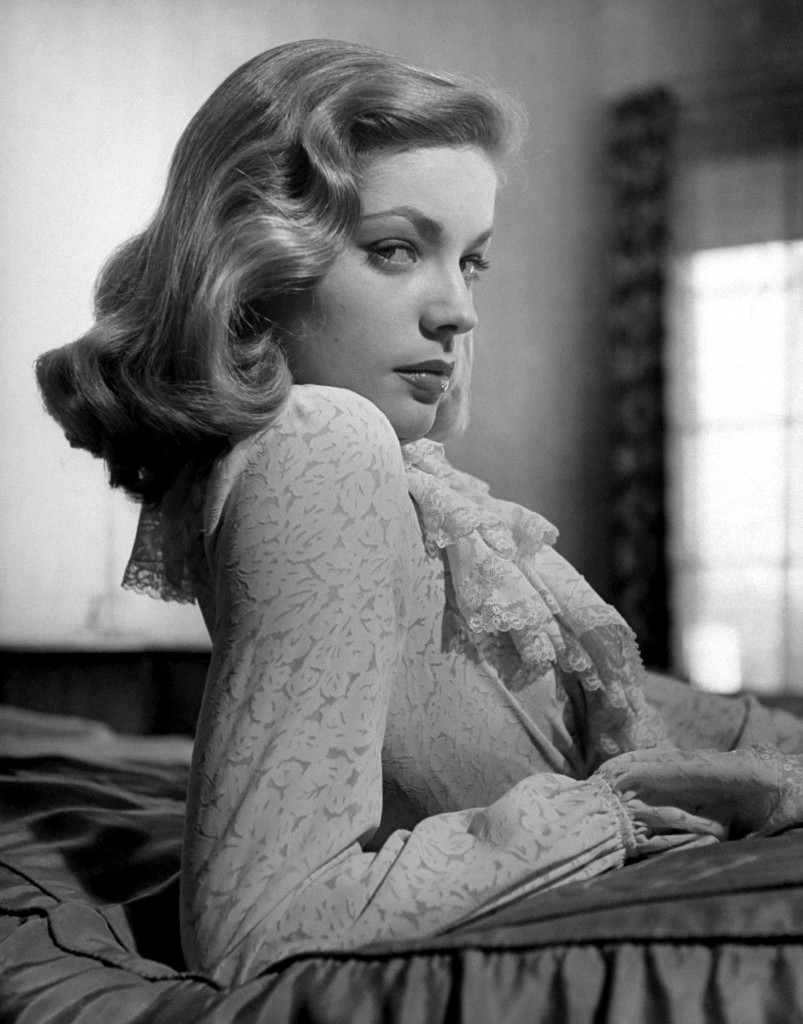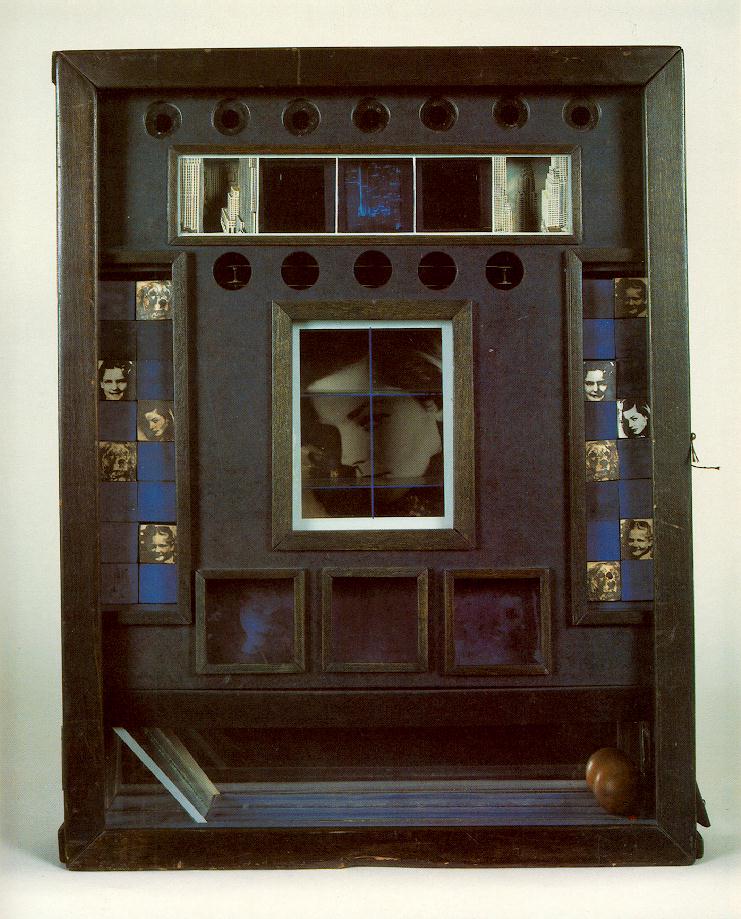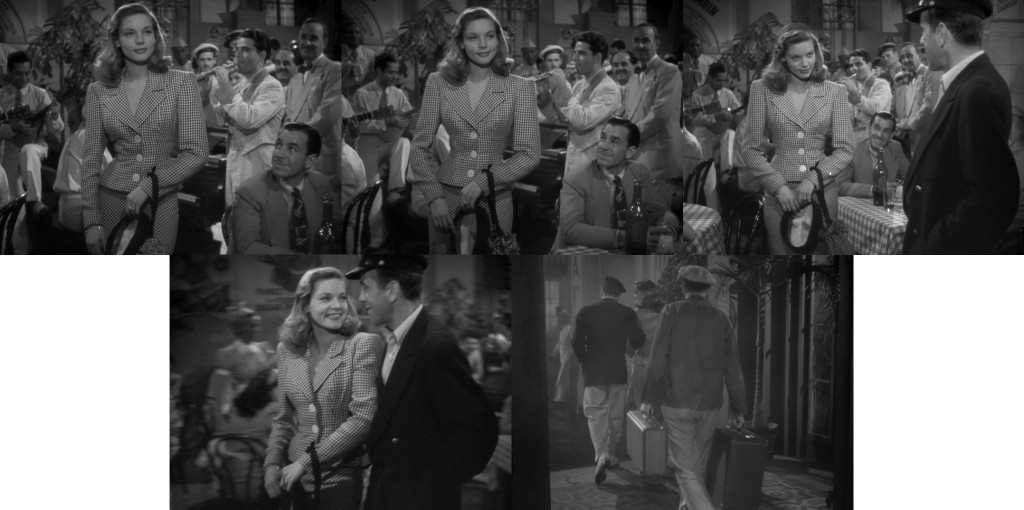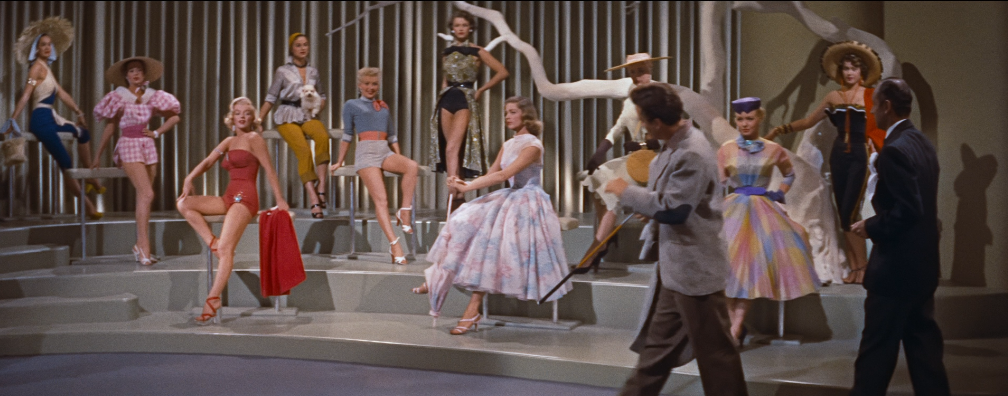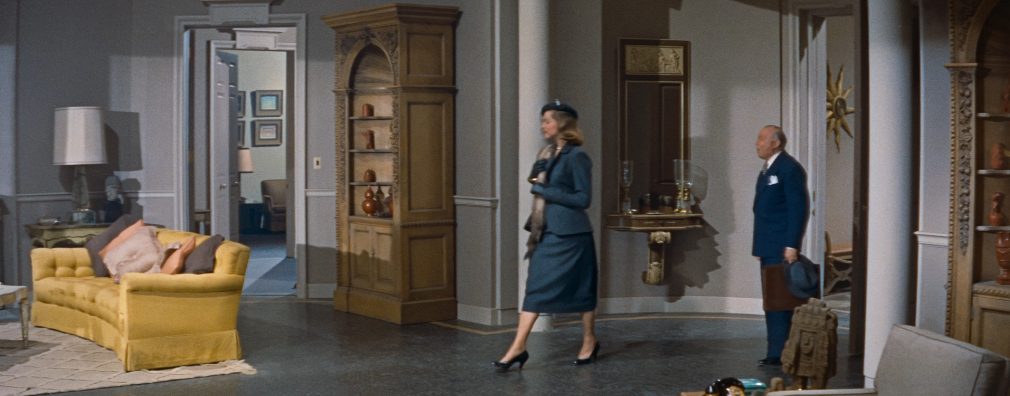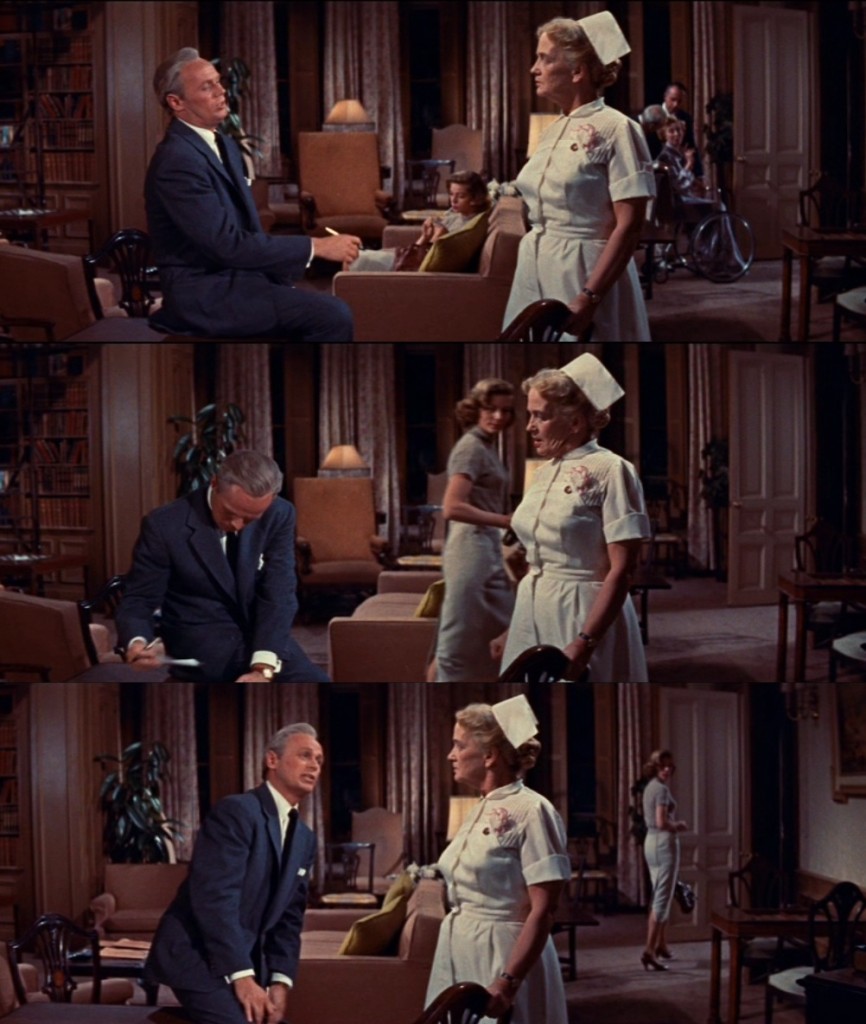Lauren Bacall: The Walk
Joe McElhaney
When Lauren Bacall emerged as a film star, with the release of Howard Hawks’s To Have and Have Not (1944), Warner Brothers dubbed her The Look – and for very good reason. Bacall’s face, her way of holding her head, sometimes with the chin slightly down as her eyes looked up, created an indelible impression. Perhaps the most notable of those who were impressed was Joseph Cornell who, after seeing To Have and Have Not, began collecting a dossier on the new star. The result of this obsession has now become one of the most famous of his mixed-media constructions, Untitled (Penny Arcade Portrait of Lauren Bacall). In the middle of this construction, tightly boxed in a window-like frame with criss-crossing lines, is a publicity portrait of Bacall from the film, her face looking out at the viewer, the chin held down in the famous pose. This face, and the deep, almost masculine voice that emerges from it, has continued to be the object of much fascination over the last eight decades. But it is neither the face nor the voice that primarily concerns me here.
In the notes taken when assembling his construction, Cornell writes of a “kindred feeling of wandering” that he detects in Bacall, a clear projection of his own flaneur-like love for wandering the streets of Manhattan. [1] In Lindsay Blair’s words, though, Cornell also “imagines [Bacall] toting for work in Manhattan’s offices, just as he himself has done.”[2] Prior to Hollywood, Bacall could, in fact, be seen “toting for work in Manhattan’s offices.” She was a fashion model and it was this, and not her struggling acting career on the stage, which brought her to the attention of Hollywood. In her most popular film of the 1950s, How to Marry a Millionaire (1953), she plays a model with the masculine name of Schatze Page; four years later, in another comedy, Designing Woman (1957) she’s a fashion designer with the more feminine (and somewhat exotic) name of Marilla Brown; four decades later, Robert Altman would cast Bacall (a small role, alas) as a color-blind fashion editor in Ready to Wear (1994), her character given the name of Slim Chrysler, an obvious reference to the nickname Humphrey Bogart’s Harry gives to Bacall in To Have and Have Not. To be able to model clothing on a runway or in a salon involves not simply being attractive while wearing and posing in the clothes; it also involves moving well and being able to walk in a striking manner. In his Time review of To Have and Have Not, James Agee noted that Bacall possessed “a born dancer’s eloquence in movement.”[3] It is precisely this “eloquence in movement” that I wish to emphasize here: not simply Lauren Bacall, The Look but also Lauren Bacall, The Walk.
For Cornell to see in the Bacall of To Have and Have Not a “kindred feeling of wandering” is partly traceable to the character of Marie that she plays in the film, herself a wanderer of sorts, apolitically drifting through various South American and Caribbean locations during the early days of World War II and without a clearly identified American home base. But Bacall’s literal way of moving through the spaces of the film has its own implications. To Have and Have Not is a major example of the emphasis in Hawks on expressive physical movement. In Hawks, characters are typically defined in an immediate and iconic fashion through the ways that they walk, wear a costume, or handle a prop. This has less to do with laying the foundation for an endless exploration of a character’s psychological “complexity” than with establishing the character’s style or essence. Hawks introduces Bacall in bits and pieces: slouching in doorways, lighting cigarettes, sitting at a table in a nightclub before she slowly walks over to the piano and joins Cricket (Hoagy Carmichael) in a performance of “Am I Blue?” During her performance of the latter, Bogart is watching her and she looks at him once. After finishing the song, Bacall walks away from the piano and over to the table where she had been sitting with a man whose persistent attentions were a source of annoyance. In a medium long-shot, possibly intended to be Bogart’s point-of-view (but no reverse angle confirms this) she bends down and almost imperceptibly picks up something that we cannot see, gives a two-fingered salute to Cricket, and walks away. (We will soon discover that she has taken the dropped wallet of the man who had been annoying her.) All of this is an ingenious way for allowing an audience to become gradually accustomed to this new personality. And then something extraordinary happens. But it happens quickly.
It begins with a cut to a closer image of her as she walks through a crowd of men, most of them sailors. It is a brief shot, lasting only a few seconds, Bacall framed from just below the waist up. She moves in a zigzag pattern through the crowd, shoulders turning left/right, left/right, eyes straight ahead, aside from a glance down at Bogart as she is about to pass his table. Bogart’s point-of-view continues to be ambiguous: Are we seeing her through his eyes, our own, or a combination of the two? Nevertheless, the entire sequence is shaped by the act of looking: Bogart at Bacall, Bacall at Bogart, and by the men she passes at the bar, most of whom turn to look at her – all slight, shifting eye movements and turns of the head. As she walks, Cricket and his band play an up-tempo version of “Limehouse Blues.” Bacall’s walk here is so fast as to be (like her stealing of the wallet) almost imperceptible in its mechanics. With her legs out of the frame, the effect is more of a glide than a walk, something stealthy and expressing a desire to be unseen even as it is fully visible and aware that it is being watched. The Look is, above all, a woman who looks back, defiantly, and then moves on. At the same time, this fast glide past the bar betrays no visible strain of hurrying, no overt signs of desperation.
In his notes on Bacall, Cornell describes her as a “girl of Botticellian slenderness.”[4] Harry’s christening of Bacall’s Marie as Slim acknowledges this slenderness, one that allows for her body to insinuate itself into her various environments and to quickly move through its spaces, detectable, but also gone before we have a chance to seize this image. Throughout much of the film, however, she moves and gestures slowly, as though the film wishes to examine and analyze what she is doing, before this will then be broken by an unexpectedly quick movement, a tension between speed and slowness that is central to Hawks. Cornell was so often searching for the power of silent cinema in present-day sound films that, for the most part, lacked such power and mystery for him. In Rose Hobart (1936), he literally slows down a sound film, East of Borneo (1931), by projecting it at silent film speed rate, rips out its soundtrack (including all dialogue) and replaces it with Brazilian samba recordings; he also tints, cuts and rearranges the original footage, thereby destroying narrative coherence, all the better to isolate the movements, facial expressions, and gestures of its female star from whom the film derives its title. With Bacall in To Have and Have Not, it is as though that slowed-down effect is already present without a need for direct manipulation of the footage, a slowness reinforced by Bacall’s deep, foggy voice, which is not a distraction for Cornell but crucial to the general effect.[5] But the elusive speed of Bacall’s movements as she passes the men at the bar strike at no less of a cinematic essence than her slowness, a walk that, through framing and staging, is something to which only a motion picture camera could do justice. For Marie and Harry to form a couple they must share (as lovers in fiction so often must) similar philosophies. But these philosophies are also given embodied movement form. Their gestural interplay through objects (most obviously, cigarettes and matches) is fundamental to this. Such objects do not come between the couple but bring them together, particularly in the classic “if you need me just whistle” seduction scene, of which Bacall’s use of the thirty dollars in paper money in her hand is a major instance. But it also given form through the ways that they walk, together and separately.
The final minutes of the film are the most striking instance of this. Steve and Slim are leaving Martinique, along with Bogart’s rummy friend Eddie (Walter Brennan). They walk down a flight of stairs that leads from the hotel rooms to the bar/ nightclub space below. Slim and Steve walk in unison, his hand touching her arm, Eddie a step behind them, carrying their luggage and moving in wider, nervous steps. Slim breaks away from Steve and walks over to the piano to say goodbye to Cricket, who asks her, “Are you still happy?” She responds first by rhetorically asking, “What do you think?” and then moves away from the piano by engaging in a seductive swaying of her hips in rhythm to an up-tempo version of a song that, earlier in the film, she had sung as a ballad, “How Little We Know.” The entire time that she is moving in this way her eyes are focused on Steve. She moves towards him and he takes her by the arm as she stops dancing. They walk together out of the club, their steps in unison again, both of them laughing at the performance of seduction that she just attempted through her dance. Like her walk past the sailors at the bar earlier in the film (she walks past that bar again in order to say goodbye to Cricket here and she is wearing the same outfit from that earlier moment) this dance happens very quickly and is over before we are able to fully process its immediate effect on us. As they walk out the door and turn right and down a foggy street, Eddie follows a few steps behind, still carrying their luggage and bobbing up and down in rhythm to the music: three individuals forming an alliance beyond conventional notions of the couple, the family, and community. The film ends with Cricket and his musicians on the bandstand, bringing the song (and the film) to a close.
The laughter that Bacall and Bogart engage in here is central. She is playing at being a seductress and both of them immediately understand the charade. Bacall was 19 when the film was being made; Bogart 45. Behind all the sophisticated posturing that Bacall engages in, her extremely young face, body and voice are quite apparent. Given Cornell’s fetish for the myth of the androgynous child/woman, Bacall’s masquerade as a sophisticated adult must have been especially potent. Nonetheless, even though her next Hawks film, The Big Sleep (1946) was shot only a year after To Have and Have Not, Bacall seems markedly more mature and assured here, if also less touching and funny. She is no longer “wandering” on the outside of the film’s social world but is firmly within it, as the member of a wealthy (albeit decadent and motherless) family. On paper, her role of Vivian Rutledge requires her to be more a conventional femme fatale and work at cross-purposes to the intentions of Bogart’s Philip Marlowe. At times, however, the coherence of Vivian’s character takes a back seat to Bacall’s star persona and to the attempt to recreate the nature of her coupling with Bogart from their previous film: Marlowe and Rutledge on the telephone in his office as they harass a police sergeant or their famous double-entendre horse race exchange in a bar.
But The Big Sleep has another brief, beautiful walk from Bacall. It occurs after Marlowe brings Vivian’s sister Carmen Sternwood (Martha Vickers) home, unconscious, presumably due to narcotics. When he enters Vivian’s home, there is a shot of her alone, lasting about five seconds, in a robe and evening gown. She walks towards Marlowe, in medium long shot, framed from head to toe but her legs hidden by the robe, her arms down at her side. In contrast to the walk across the bar in To Have and Have Not, this one is slower, more direct, her arms at her side, as though her defenses have been lowered and she is able to face Marlowe. But this walk, too, is over and done with before we are able to fully assess its effect. In contrast to To Have and Have Not, which only introduces one other major female character fairly late in the proceedings and who is never a serious threat to Bacall’s Slim, The Big Sleep contains what seems like a never-ending supply of sexual women at Marlowe’s fingertips. Nevertheless, all of these women are, for various reasons, inadequate to Bacall and this inadequacy is often played out through movement ideas. Quite simply, none of them move or walk as effectively as Bacall’s Vivian. To varying degrees, these other women all seem to have “pointed toes” that expose their inadequacies all too clearly. The drug addicted and highly sexualized Carmen, for example, is defined by her difficulty in being able to simply maintain a vertical position for long. “She tried to sit on my lap while I was standing up” is how Marlowe describes his initial meeting with her. When Marlowe later brings her home, passed out in the back seat of his car, he tells Vivian, “I’ve got your sister outside but she’s not walking very well.” In another sequence, when Carmen desperately crawls across the floor in order to retrieve a dropped gun, Marlowe tells her to get up because “you look like a Pekinese.”
By contrast, Vivian displays an almost total command of movement and gesture. She never crawls. Even her occasional moments of nervous slippage are witnessed by Marlowe alone, as though only he has privileged access to this flawed aspect of her. During their first meeting, at her home, she walks towards him slowly, one finger hitched in her right pants pocket, while speaking and making direct eye contact, then takes a few steps away from him and turns around; or she slowly walk over to the window, opens it, then turns back and sits on the window ledge as she speaks to him, all more or less at the same rhythm, as though attempting to set a trap for him, but also conveying the act of thought through walking as much as talking:
Seduction in this film is above all a question of the body in motion. The outrageous horse racing sexual metaphors that are central to the dialogue between Vivian and Marlowe in the bar, which bring together the film’s human/animal connections, as well as the love for gambling that both of these characters share, situate sexual desire and activity as a question of seeing someone move “over a distance of ground.” The final sequence of the film has Marlowe’s hands and feet tied as he sits on the floor, unable to walk, stand or gesture, and it is Vivian’s decision to literally break these ties, to restore movement to him, that becomes the culminating moment in solidifying their relationship.
“I would never reach the To Have and Have Not heights again,” Bacall later wrote.[6] She ascribed this to problems in studio miscasting, particularly due to Hawks severing his professional ties with her after The Big Sleep, as well as to her decision to become Bogart’s wife assuming precedence over a film career. I suspect, though, that the problems are more complex than this. In some ways, the rest of Bacall’s career can be seen as an attempt to either recapture or resist the wandering Slim of To Have and Have Not. Delmer Daves’s Dark Passage (1947), the third of her films with Bogart, is almost entirely concerned with the face, the film taking a cue from its own scenario revolving around the identification and transformation of Bogart’s face; and in her final collaboration with Bogart, John Huston’s Key Largo (1948), she mainly alternates between the positions of passive witness to, or moral compass for, Bogart’s character. In both films, her movements are comparatively restricted due to the conceptual logic of the projects. As Andrew Britton has argued, Bacall in these films, unlike To Have and Have Not or The Big Sleep, “could easily be replaced by half a dozen other actresses without seriously affecting meaning, mode or conception.”[7] The same could be argued for her presence in two major Michael Curtiz films from 1950, Young Man with a Horn and Bright Leaf. She’s a striking presence in both of these, particularly Young Man. But Curtiz’s ingeniously mobile and expressive frames do not require the specificity of Bacall in movement in the way that the two Hawks films do. Their meaning precedes Bacall’s arrival on the set.
Two very different CinemaScope films from the fifties, though, create distinct spaces for her to move within. In Jean Negulesco’s comedy How to Marry a Millionaire, Negulesco’s seemingly cautious use of the new ‘scope frame (this was the second feature released in the process) serves to create the effect of a vast, open terrain, reinforced through long takes, within which Bacall and her two co-stars, Marilyn Monroe and Betty Grable may walk, sit, and stand. The three women move in their own distinct manner: Monroe takes small, quick steps, the legs brushing against one another, with an emphasis on a swinging rear end that seems to follow the rest of her body from about two steps behind; Grable tends to take broader, more confident steps, at times happily striding across a room, everything about her movements suggesting openness and transparency. Monroe and Grable are, in different ways, comic performers, showgirls, and their status as sex symbols is also predicated on a display of flesh, of bare legs. Bacall’s importance as a film star, on the other hand, is not fundamentally comic, even though her presence otherwise depends upon a strongly ironic presentation of self within otherwise melodramatic situations. In the fashion show sequence from the film, both Grable and Monroe model outfits in which their legs and rear ends are displayed, Grable through short pants and Monroe through a bathing suit. But Bacall wears a tea dress that tapers in at the waist but covers much of her legs and de-emphasizes the specific contours of much of her body, even as the shape of the dress allows for the act of walking to become that much further emphasized.
This downplaying of Bacall’s legs throughout her career creates an almost platonic idea of the walk. Unlike her idol, Bette Davis, whose hips famously swing in a mannered fashion, as though divorced from the brain from which they should rightly take their cue, Bacall’s emphasis on the hips creates a sense of constant control over every step she takes. (Schatze is, in fact, the “brains” of this particular trio.) Unlike Bacall’s longtime friend Katharine Hepburn, there is nothing athletic, nothing conventionally “healthy” about the way Bacall can dominate a space by moving through it. Slim Hawks (Howard Hawks’s wife at the time To Have and Have Not was shot and who was partly the inspiration for Bacall’s nickname, as well as personality, in the film) once described Bacall as having “a bit of the panther about her.”[8] But the jungles through which Bacall prowls are strictly urban. The opening of How to Marry a Millionaire is virtually a display of this tendency, as she slowly walks about the abandoned apartment she wishes to rent. Negulesco films her in long shot and in almost one sustained take throughout this opening, her body visible from top to bottom. Her capacity to dominate a space resides in the deliberate movements of her hips and shoulders, her walk cutting a wide path, one leg broadly crossing over the other.
Two years later, in Vincente Minnelli’s melodrama about a psychiatric sanitarium, The Cobweb (1955), we find another film in which the implications of Bacall as an expressive cinematic walker are mobilized. Typical of Minnelli, sequences in The Cobweb are built around an ornate choreography of sitting, lying down, walking, running – always this problem in Minnelli of how to dominate a space simply through one’s physical presence.[9] Unlike Negulesco’s vast, sparsely populated interiors, Minnelli will typically fill the wide frame of The Cobweb with bodies and expressive décor. William Gibson, the author of the novel on which the film was based, has specifically complained about Bacall in the film. Visiting the set one day, he took note of her “walking in front of the camera, in a scene where she’s crossing a field, and there she was swinging her ass very sexily and I thought, Has she not read the part? This character has just lost her husband and her child. She’s in a state of mourning. She’s not swinging her ass.”[10] But, in fact, Minnelli uses this walk of Bacall’s to very specific effect.
Early in the film, her character of Karen refers to herself as an “innocent bystander.” It is her first line of dialogue but it is also an idea that is given form throughout the film due to the ways that Bacall is placed in the frame. In two sequences in the first half of the film, both set in the sanitarium library and both shot in one extended take, Bacall will walk from middle distance to the rear of the shot and then back to the middle again as crucial foreground action from which she has been excluded occurs; or she will sit on a couch, light and smoke a cigarette and then rise from the couch and walk behind the principle foreground activity before exiting to the far right of the frame. As most of the other actors come and go, Bacall alternates between observing the surrounding action, participating in it but at a clear remove, and ignoring it (or sometimes pretending to, as a form of social decorum).
Throughout the rest of the film, Bacall continues to play out her status as a bystander in various ways, such as in the sequences of developing intimacy between Karen and the head of the clinic, Dr. McIver (Richard Widmark). Their relationship is articulated as much through the act of walking (in particular, through two crane shots that take them up a flight of exterior stairs and into her second-floor apartment) as through dialogue. Both of them pace about, sit and stand, and handle objects in her apartment in a way that conveys both their attraction for one another and their hesitancy about acting on this “impossible” attraction. (McIver is married.) For Minnelli, as for Hawks, to walk is not simply a way of moving through a space, or of getting from one location to another. It is also a way of articulating and embodying the very act of thought itself, of contemplation and cunning, in which there is an implied dialogue between the rhetorical force of the camera and the mobile body of the actor. If, by the time of The Cobweb, Bacall is no longer the teenage Botticellian beauty that so enchanted Cornell but is instead a firmly grounded, mature, and somewhat melancholy figure, she nevertheless continues to seductively wander through and bear witness to her films.
Joe McElhaney is a professor in the Department of Film and Media Studies at Hunter College and in the Theatre Program at the City University of New York Graduate Center. His books include The Death of Classical Cinema: Hitchcock, Lang, Minnelli; Vincente Minnelli: The Art of Entertainment; Albert Maysles; and the forthcoming A Companion to Fritz Lang. His essays have appeared in numerous collections and journals.
[1] Lindsay Blair, Joseph Cornell’s Vision of Spiritual Order (London: Reaktion Books, 1998), 142.
[2] Ibid.
[3] James Agee, Agee on Film, Volume 1 (New York: Perigee Books, 1983), 354.
[4] Blair, 143.
[5] The relationship between Bacall in this film and Marlene Dietrich in her films for Josef von Sternberg, in particular Morocco (1930) and Shanghai Express (1932) has often been noted. See, for example, Todd McCarthy, Howard Hawks: The Grey Fox of Hollywood (New York: Grove Press, 1997), 369.
[6] Lauren Bacall, By Myself and Then Some (New York: Harper Collins Publishers, Inc., 2005), 165.
[7] Andrew Britton, Katharine Hepburn: Star as Feminist (New York: Continuum, 1995), 185.
[8] McCarthy, 363.
[9]Bacall on The Cobweb: “I will never forget when we were rehearsing this one scene, I was sitting on a sofa between Lillian Gish and Oscar Levant, and I had my left leg crossed over my right and I was just sitting there. Vincente was walking back and forth, in front of us while we were rehearsing and he’s humming the whole time….and he suddenly walked over to me and lifted my left leg and put it on the floor and then picked up my right leg to cross over my left leg. What that meant to him I’ll never know…” From Mark Griffin, A Hundred or More Hidden Things: The Life and Films of Vincente Minnelli (New York: Da Capo Press, 2010), 180
[10] Ibid.

